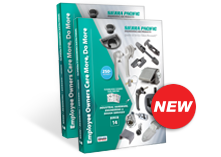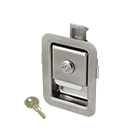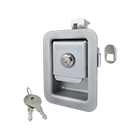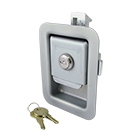High-Quality Toggle Clamp for Industrial and Commercial Applications
During mechanical processes and tasks, clamps and latches are essential in holding workpieces tightly together and securing them to jigs and fixtures. The most common type is the toggle clamp latch, which combines a simple design with an impressive locking mechanism, substantial clamping force, and capable security.
These durable hardware components come in various versions, configurations, sizes, and holding capacities to accommodate different industrial applications. They are commonly used in production lines and other manufacturing processes where components need to be held securely and then removed quickly repeatedly. Toggle clamps are easy to use and are trusted in many industries, including woodworking, metalworking, and manufacturing, to ensure precision and safety. Discover our selection of toggle clamps and toggle clamp accessories.
More About This Section
What types of customers does SPEP offer toggle clamps to?
Sierra Pacific Engineering and Products (SPEP) sells business-to-business (B2B). We’re the experts in supporting OEM customers with high-quality industrial hardware, like toggle clamps. We are a perfect match for any company that uses high volumes of parts and/or is a repeat producer of products that require hinges, latches, handles, locks, and other similar items.
Our engineering, manufacturing, and distribution strengths provide a valuable resource to our customers. We regularly assist in product development, product improvement, and developing supply chain programs to service the demand of our customers.
Do you sell toggle clamps to the general public?
No, SPEP does not sell toggle clamps to the public, as we are not a retail establishment. We sell business-to-business (B2B) only. If you need a source for toggle clamps in small quantities, we encourage you to visit our partner, Hard-To-Find Hardware at www.HTFHardware.com.
Are you ISO certified?
Yes! SPEP is ISO 9001:2015 certified. You can learn more about this on the About Us page of our website.
What is an industrial toggle clamp?
Toggle clamps are pieces of industrial equipment used to securely hold other components in place during machining, assembly, or inspection. It works via a pivot and level system that applies clamping force through a toggle action. This then locks the clamp in position.
Toggle clamps are known for their quick operation, reliable holding power. They’re commonly used in jigs, fixtures, and manufacturing setups where speed and repeatability are important. Learn more about how toggle clamps work and why you need them.
Which industries use toggle clamps?
Toggle clamps are highly versatile, making them ideal for a wide range of applications in various industries, including but not limited to:
- Manufacturing – Assembly lines and machining processes for new products
- Automotive industry – Vehicle assembly and car component manufacturing
- Marine industry – Securing panels and equipment fastening
- General instream use – Workshop setups for general work holding uses and jig and fixture construction
What are the key features of toggle clamps?
Toggle clamps have a simple design but are made with key features that enhance their effectiveness. Put simply, the clamping arm holds the workpiece, the lever arm activates the clamp, and the base anchors the unit to a work surface. Together, these parts create a strong and reliable holding mechanism that offers the following benefits:
- High Holding Capacity: When locked, toggle clamps can withstand forces over 2,000 lbs. This makes them highly suitable for heavy-duty applications.
- One-Handed Operation: Simple toggle action allows for quick and easy use with minimal effort.
- Secure Locking Mechanism: Maintains a firm hold on the desired workpiece throughout the task, preventing movement.
- Fast Setup and Alignment: Anchored base simplifies positioning compared to two-jaw clamps.
- Versatile Use: Ideal for weld fixturing, injection molding, machine tool setups, gauging, and more.
What types of toggle clamps does SPEP offer?
SPEP offers several types of quick-release toggle clamps to suit the needs of many different businesses. They are available in steel or stainless steel and can be zinc-plated steel or mill-finished if desired. Hand levers are available in inch and metric sizes.
Our selection of toggle clamps includes:
- Vertical & Vertical Action Hold-Down Clamps: This is the most universally used toggle clamp. Workpieces are secured by a bar that swings down and clamps tightly. When closed, the clamp’s handle is in a vertical or upright position.
- Hold-Down Horizontal Toggle Clamp: The horizontal or horizontal action clamp is a variation of the vertical toggle clamp. The piece of manufacturing equipment applies holding force in a horizontal position. The low profile is beneficial when more clearance is needed or to keep the operator’s hand away from the clamp during operation.
- Push-Pull Clamp: Another common toggle clamp is a push-pull toggle clamp. As the name suggests, it features a push or pull action to apply force in a direct, straight-line action. A push or pull-action latch toggle clamp is helpful when the operator needs it to apply force by pushing or pulling forward. When mounted vertically and locked, the clamp prevents components from falling forward.
- Latch Action Toggle Clamp: This toggle clamp features a hook type that connects with a keeper. It works like an access latch to clamp, position, and seal.
- Heavy-Duty Toggle Clamp: Heavy-duty toggle clamps are generally reserved for jobs that require additional holding capacity. These clamps are tested to provide 700+ lbs. of capacity.
What materials are available for toggle clamps?
At SPEP, we offer high-quality toggle clamps made from either high-grade steel or stainless steel with corrosion-resistant coatings. Using one of these materials, we can fully customize your toggle clamps based on your business’ needs.
How do I choose the right toggle clamp for my business?
When choosing the ideal toggle clamp, consider the following:
Application Requirements
Some toggle clamps are better suited for certain applications than others. Load capacity and environmental conditions should factor into the selection process to ensure you’re choosing the right toggle clamp for the job.
Material Considerations
Toggle clamps are available in various coatings and finishes. Most toggle clamps are made with pressed steel components with a zinc-plated finish. These materials are acceptable for a variety of applications. For marine applications and circumstances where toggle clamps must perform in rough conditions, corrosion-resistant finishes and stainless steel are ideal.
Size and Dimensions
A toggle clamp isn’t effective if it can’t hold the item. Knowing the measurements of the components you'll be working with can help you choose the proper hardware.
How do I install a toggle clamp latch?
To install a new toggle clamp, always follow the manufacturer's installation guide. This typically includes securing the baseplate and adjusting the latch arm for proper tension, like so:
- Choose the Mounting Surface: Select a stable jig, movable working surface, or table where the toggle clamp will be installed.
- Align the Clamp: Position the clamp so that when engaged, the clamping arm aligns properly with the workpiece.
- Secure the Base: Use the holes in the flanged base to bolt the clamp down. Check to make sure it's tightly fastened to prevent any shifting during use.
- Check for Stability: Once installed, test the clamp by applying force. There should be no movement or looseness if installed correctly.
Can toggle clamp latches be used outdoors?
Yes, toggle clamp latches can be used outdoors, especially those made from stainless steel or with special coatings to resist environmental factors.
How do I maintain a toggle clamp?
Like any other piece of equipment, toggle clamps are susceptible to wear and tear. Users should routinely inspect their clamps for signs of aging, misalignment, and weak points. Users should keep toggle clamps clean, lubricated, and aligned to ensure longevity.
Is there a minimum order requirement for toggle clamps?
Yes, the minimum order amount for a new customer's first purchase of toggle clamps is $250. Subsequent orders have a $50 combined minimum.
How can I place a toggle clamp order with SPEP?
Placing your toggle clamp order is a simple consultation away. Reach out to use via:
- Emailing order@spep.com
- Calling (800) 433-5554
- Faxing (800) 301-8522
Does SPEP accept will call orders for toggle clamps?
Yes, will call orders are accepted for toggle clamps, but must be called in or emailed to order@spep.com first. You’ll receive an email notification once your shipment is ready for pickup.
What are SPEP’s hours of operation?
SPEP’s hours of operation are 8:00am to 4:30pm local time Monday through Friday at each of our three warehouses (CA, IL, & TX). Our customer service lines are open 5:00am to 5:00pm Pacific time.
Can I place a toggle clamp order after business hours?
Yes, toggle clamp orders can be placed anytime by emailing order@spep.com. We typically process orders within 24 hours, though orders received during off-hours may take longer to process.
How are toggle clamp prices determined?
Toggle clamp prices quoted or acknowledged are based on Sierra Pacific Engineering and Products (SPEP) current cost of material and labor. All of our standard pricing is based on tiered price breaks for single shipment quantities.
Can I pay for toggle clamps using a credit card?
Yes! Customers are not required to be set up on credit terms, and can instead pay using a credit card at the time of shipment. Credit cards may also be used to pay for orders in the meantime while credit terms are being evaluated.
Does SPEP offer high-volume pricing for toggle clamps?
Yes! Special pricing beyond the standard matrix may also be available for catalog items ordered in especially high volumes. Price breaks for custom items are evaluated based on estimated annual usage (EAU) expectations and minimum order quantity (MOQ) to cover production lead times.
What is SPEP's policy on over-runs and under-runs?
Unless otherwise specified, Customers agree to accept over-run or under-run volumes not exceeding 10% of quantities ordered. In cases where an overrun or under-run exceeds 10%, we may request acceptance in writing from the customer.
What shipping method do you use for toggle clamps?
SPEP prefers to ship toggle clamps “freight collect” using any carrier our customers specify. In the absence of specific shipping instructions, we will use our own discretion in choosing a carrier.
SPEP assumes no responsibility for any such damage or loss or for transportation delays. We are also not responsible for insuring shipments unless specified by the customer, in which event such insurance shall be based on the customer’s valuation and at the customer’s expense. All claims for damage and loss, whether apparent or concealed, shall be filed by the customer with the carrier. Shortages and/or damage must be noted at the time of delivery.
Does SPEP accept international orders for toggle clamps?
Yes, SPEP ships orders worldwide from our US-based warehouses. Under appropriate circumstances, we can even coordinate “China to China” shipments directly from the factory.
How long will it take to receive my toggle clamp order?
How long it takes to receive your toggle clamp order will depend on when it was placed and the due date referenced in your purchase order. If no due date is given, your order will be shipped ASAP.
Upon receiving your order, SPEP provides an order acknowledgement with an estimated ship date. Any shipment date specified shall be the date of shipment from our plant. Shipment dates given by our order desk are estimates unless otherwise indicated.
Delivery may be subject to delays caused by strikes, fires, floods, accidents, pandemics, or any other cause beyond our control, including delays in the delivery of material to SPEP by third parties.
Can I change my toggle clamp order?
Yes, you can change your toggle clamp order. Change requests made after production has started will convert the order to a time and cost of materials basis unless we’ve agreed in writing to a price revision that reflects the cost of the changes. No changes may be made without SPEP’s prior written authorization.
Can I cancel my toggle clamp order?
Any toggle clamp order placed with and accepted by SPEP may be canceled only with the written consent of SPEP, upon payment of all expenses already incurred on the order by SPEP prior to the effective date of cancellation.
What is your warranty policy for toggle clamps?
SPEP guarantees defect-free materials and workmanship for 120 days from delivery. If a product is found to be defective, we will approve returns with an R.M.A. number and may replace or refund the item.
PLEASE NOTE that this warranty does not cover damage from misuse, improper installation, or environmental wear. SPEP is not responsible for removal, reinstallation, or incidental costs. No additional warranties, express or implied, apply.
What is your return policy for toggle clamps?
If returns are necessitated due to errors of SPEP, the customer must obtain an R.M.A. Once obtained, SPEP will cover the cost.
If the customer made an error, only unused catalog items may be returned within 30 days through prior approval, an R.M.A., prepaid shipping, and a 20% restocking fee (minimum $25). Special orders cannot be returned unless defective.
Can I access toggle clamp samples?
You can download or view a PDF catalog right here on our website. You can also use the search function on our site to browse and filter parts by category or industry. Please contact us at (800) 433-5554 or sales@spep.com for sample and quote requests, as well as other inquiries.
